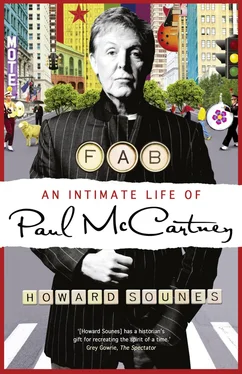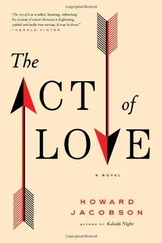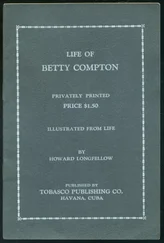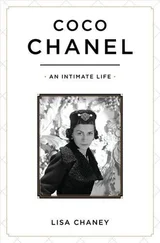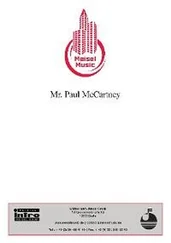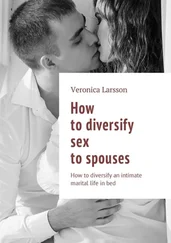Paul’s maternal grandfather, Owen Mohin, was a farmer’s son from County Monaghan, south of what is now the border with Northern Ireland, and it’s likely there was Irish blood on the paternal side of the family, too. McCartney is a Scottish name, but four centuries ago many Scots McCartneys settled in Ireland, returning to mainland Britain during the Potato Famine of the mid-1800s. Paul’s paternal ancestors were probably among those who recrossed the Irish Sea at this time in search of food and work. Great-grandfather James McCartney was also most likely born in Ireland, but came to Liverpool to work as a housepainter, making his home with wife Elizabeth in Everton, a working-class suburb of the city. Their son, Joseph, born in 1866, Paul’s paternal grandfather, worked in the tobacco trade, tobacco being one of the city’s major imports. He married a local girl named Florence Clegg and had ten children, the fifth of whom was Paul’s dad.
Aside from Paul’s parents, his extended Liverpool family, his relatives – what Paul would call ‘the relies’ – have played a significant and ongoing part in his life, so it is worth becoming acquainted with his aunts and uncles. John McCartney was Joe and Flo McCartney’s firstborn, known as Jack. Paul’s Uncle Jack was a big strong man, gassed in the First World War, with the result that after he came home – to work as a rent collector for Liverpool Corporation – he spoke in a small, husky voice. You had to lean in close to hear what Jack was saying, and often he was telling a joke. The McCartneys were wits and raconteurs, deriving endless fun from gags, word games and general silliness, all of which became apparent, for better or worse, when Paul turned to song writing. McCartney family whimsy is in ‘Maxwell’s Silver Hammer’ and ‘Rocky Raccoon’, also ‘Rupert and the Frog Song’.
There was a son after Jack who died in infancy; then came Edith (Edie) who married ship steward Will Stapleton, the black sheep of the family; another daughter died in infancy; after which Paul’s father, James, was born on 7 July 1902, known to all as Jim. He was followed by three girls: Florence (Flo), Annie and Jane, the latter known as Gin or Ginny, after her middle name Virginia. Ginny, who married carpenter Harry Harris, was Paul’s favourite relative outside his immediate family and close to her younger sister, Mildred (Milly), after whom came the youngest, Joe, known as Our Bloody Joe, a plumber who married Joan, who outlived them all. Looking back, Joan recalls a family that was ‘very clannish’, amiable, witty people who liked company. In appearance the men were slim, smartly dressed and moderately handsome. Paul’s dad possessed delicate eyebrows which arched quizzically over kindly eyes, giving him the enquiring, innocent expression Paul has inherited. The women were of a more robust build, and in many ways the dominant personalities. None more so than the redoubtable Auntie Gin, whom Paul name-checks in his 1976 song ‘Let ’em In’. ‘Ginny was up for anything. She was a wonderful mad character,’ says Mike Robbins, who married into the family, becoming Paul’s Uncle Mike (though he was actually a cousin). ‘It’s a helluva family. Full of fun.’
Music played a large part in family life. Granddad Joe played in brass bands and encouraged his children to take up music. Birthdays, Christmas and New Year were all excuses for family parties, which involved everybody having a drink and a singsong around the piano, purchased from North End Music Stores (NEMS), owned by the Epstein family, and it was Jim McCartney’s fingers on the keys. He taught himself piano by ear (presumably his left, being deaf in his right). He also played trumpet, ‘until his teeth gave out’, as Paul always says. Jim became semi-professional during the First World War, forming a dance band, the Masked Melody Makers, later Jim Mac’s Band, in which his older brother Jack played trombone. Other relatives joined the merriment, giving enthusiastic recitals of ‘You’ve Gone’ and ‘Stairway to Paradise’ at Merseyside dance halls. Jim made up tunes as well, though he was too modest to call himself a songwriter. There were other links to show business. Younger brother Joe Mac sang in a barber-shop choir and Jack had a friend at the Pavilion Theatre who would let the brothers backstage to watch artists such as Max Wall and Tommy Trinder perform. As a young man Jim worked in the theatre briefly, selling programmes and operating lights, while a little later on Ann McCartney’s daughter Bett took as her husband the aforementioned Mike Robbins, a small-time variety artiste whose every other sentence was a gag (‘Variety was dying, and my act was helping to kill it’). There was a whiff of greasepaint about this family.
Jim’s day job was humdrum and poorly paid. He was a salesman with the cotton merchants A. Hannay & Co., working out of an impressive mercantile building on Old Hall Street. One of Jim’s colleagues was a clerk named Albert Kendall, who married Jim’s sister Milly, becoming Paul’s Uncle Albert (part of the inspiration for another of Paul’s Seventies’ hits, ‘Uncle Albert/Admiral Halsey’). It was perhaps because Jim was having such a grand old time with his band and his extended family that he waited until he was almost forty before he married, by which time Britain was again at war. It was Jim’s luck to have been too young to serve in the First World War, and now he was fortunate to be too old for the Second. He lost his job with Hannay’s, though, working instead in an aircraft factory during the day and fire-watching at night. Liverpool’s docks were a prime German target during the early part of the war, with incendiary shells falling almost nightly. It was during this desperate time, with the Luftwaffe overhead and Adolf Hitler’s armies apparently poised to invade from France, that Jim McCartney met his bride-to-be, Paul’s mother Mary.
Mary Mohin was the daughter of Irishman Owen Mohin, who’d left the old country to work in Glasgow, then moving south to Liverpool, where he married Mary Danher and had four children: a daughter named Agnes who died in childhood, boys Wilfred and Bill, the latter known as Bombhead, and Paul’s mother, Mary, born in the Liverpool suburb of Fazakerley on 29 September 1909. Mary’s mother died when she was ten. Dad went back to Ireland to take a new bride, Rose, whom he brought to Liverpool, having two more children before dying himself in 1933, having drunk and gambled away most of his money. Mary and Rose didn’t get on and Mary left home when still young to train as a nurse, lodging with Harry and Ginny Harris in West Derby. One day Ginny took Mary to meet her widowed mother Florence at her Corporation-owned (‘corpy’) home in Scargreen Avenue, Norris Green, whereby Mary met Gin’s bachelor brother Jim. When the air-raid warning sounded, Jim and Mary were obliged to get to know each other better in the shelter. They married soon after.
Significantly, Paul McCartney is the product of a mixed marriage, in that his father was Protestant and his mother Roman Catholic, at a time when working-class Liverpool was divided along sectarian lines. There were regular clashes between Protestants and Catholics, especially on 12 July, when Orangemen marched in celebration of William III’s 1690 victory over the Irish. St Patrick’s Day could also degenerate into street violence, as fellow Merseysider Ringo Starr recalls: ‘On 17th March, St Patrick’s Day, all the Protestants beat up the Catholics because they were marching, and on 12th July, Orangeman’s [sic] Day, all the Catholics beat up the Protestants. That’s how it was, Liverpool being the capital of Ireland, as everybody always says.’ Mild-mannered Jim McCartney was agnostic and he seemingly gave way to his wife when they married on 15 April 1941, for they were joined together at St Swithin’s Roman Catholic Chapel. Jim was 38, his bride 31. There was an air raid that night on the docks, the siren sounding at 10:27 p.m., sending the newlyweds back down the shelter. Bombs fell on Garston, killing eight people before the all-clear. The Blitz on Liverpool intensified during the next few months, then stopped in January 1942. Britain had survived its darkest hour, and Mary McCartney was pregnant with one of its greatest sons.
Читать дальше
